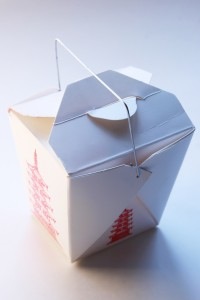 You can probably find Chinese take-out food in white containers with wire handles in just about any part of the United States and in many other parts of the world.
You can probably find Chinese take-out food in white containers with wire handles in just about any part of the United States and in many other parts of the world.
Although those folded white paperboard containers immediately signify the type of food that’s inside, their derivation is, well, American.
It’s Really An Oyster Pail
The Chinese takeout container was patented in Chicago, on Nov. 13, 1894, by Frederick Weeks Wilcox. He created a “paper pail” from a single piece of paper that was creased into segments and then folded into what was, hopefully, a leak-proof container with a wire handle on top. The support folds were on the outside — creating a flat inside surface which made it pretty easy to slide food smoothly onto a plate.
The whole idea was based on an oyster pail – a wooden pail used to transport oysters. The paper oyster pail was developed when oysters, which were very popular and used to be more plentiful and less expensive than they are today, were shucked by an oyster seller when they were purchased. The raw oyster meat was then taken home to be used in cooked dishes. Because shucking oysters requires some amount of skill to avoid badly cut fingers, having someone else do this was a good thing. So, after the oyster seller wrestled the shells open, the dripping oyster meat that was removed had to be transported in something. The paper oyster pail proved to be an inexpensive and sanitary way to do this.
Takeout Food Becomes Popular
After the Second World War, Americans developed a huge interest in prepared food that could be picked up from restaurants and heated up at home. Because it’s tasty, a little different, pretty cheap, and travels well, American Chinese food became very popular.
The Adaptable White Box
When oyster availability started to decline and Chinese takeout food started to become popular, the nearly leakproof, durable, disposable, inexpensive, and available oyster pail was quickly adopted for “Chinese take-out.”
And, for good reason. The design of the box is multi-purpose. It usually self-closes with a tab and because of the way the box is folded, it allows some steam to escape from hot food. If you’re careful, you can remove the flaps, unfold the sides, and use the container as a flimsy plate.
Over time, some adjustments have been made in the boxes that make them more suitable for the modern-day kitchen: you can find microwave-safe cartons that use glue instead of wire along with dye free and unbleached environmentally friendly varieties.
But, one thing has not changed. As most takeout food lovers know, one of the best things about the uniquely shaped box is that with the long reach of chopsticks you can still eat right out of the container.

Leave a Reply